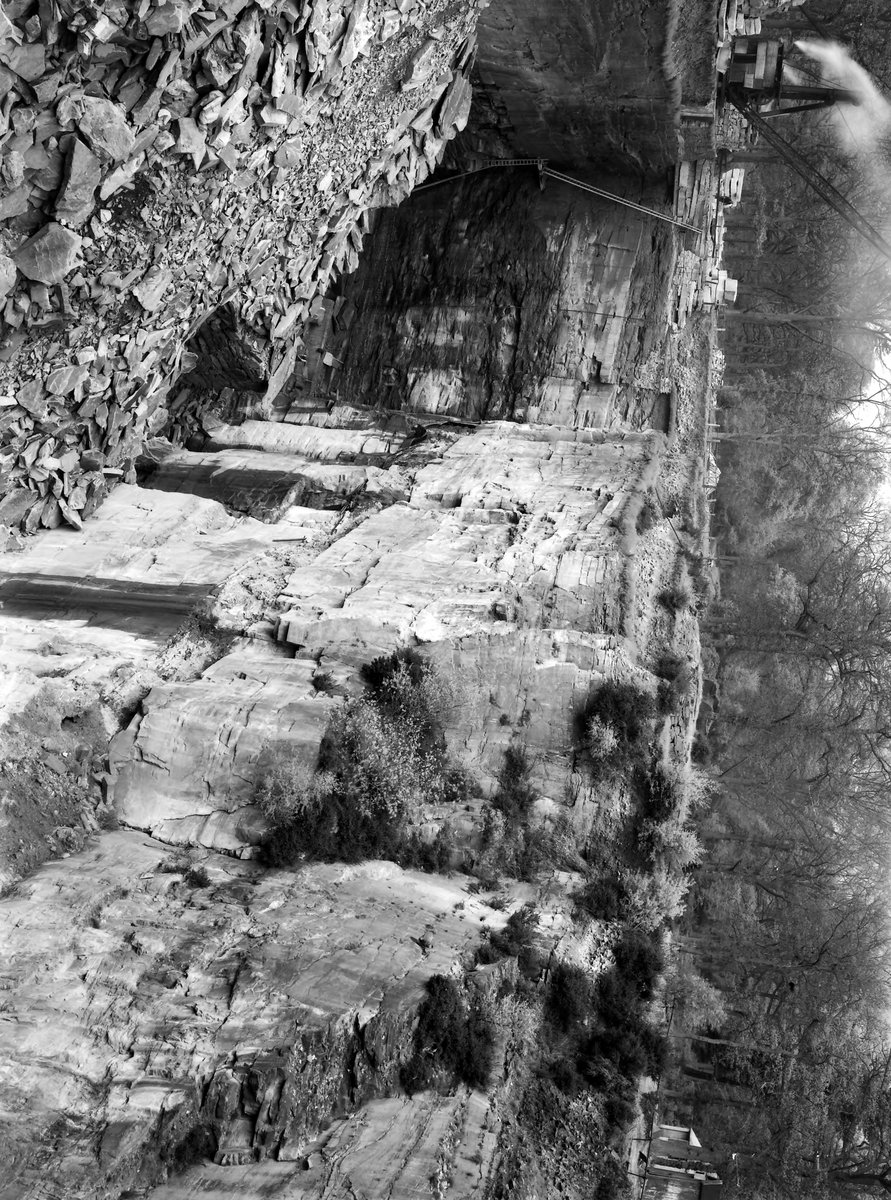Partly active site - Please stay away from the working quarry area.
Many of the original stone sleeper blocks from the tramroad survive along the track, though the rails are long gone. Spoil tips, infilled adits, and loading platforms line the route, while a few mines remain accessible.
Notably, Bixslade still hosts some limited stone extraction. Forest of Dean Stone Firms, established around 1900, continue to operate near Lower Cannop Pond, where ashlar is cut from blocks quarried at Bixhead. Mine Train Quarry, higher up the valley, is worked in a small way by one quarryman, and quarrying activity there has exposed entrances to the former Birch Hill or Stopford’s Iron Mine. The disused western quarry is now heavily overgrown, but a path on its northern edge leads steeply down to the floor where a low crawl gives access to the underground workings.
Inside, large chambers open out, supported in places by steel bars driven into the walls or roof, with other sections left entirely unsupported. Water has collected in the lower areas to a depth of around three feet, but a long plank allows it to be crossed. The atmosphere is striking—more reminiscent of the vast slate mines of North Wales than typical Forest workings. Higher chambers can be reached via steep slopes and climbs using chains or handrails. Drill marks are still visible throughout, and one deep pit on the site connects directly to these underground spaces.
Coal was also extracted from the valley via pits, shafts, and three main levels driven into the Coleford High Delf seam. Bixslade Low Level, identifiable by a keystone dated 1810 near Mine Train Quarry, and Bixslade High Level, begun in 1826, were among them. A fenced-off, stone-lined shaft further up the valley—now blocked at twenty feet—is believed to descend 200 feet to Miles Water Level. The shaft follows an easy pitch, though beyond it lie unstable chambers and a small stream with no further way on.
The quarry sites were last worked in the 1960s, and a tragic drowning incident in the 1970s prompted the drainage of the flooded pits. Some underground passages were briefly exposed by quarrying operations in the 1990s, though many have since been sealed again.
- 1940-1950 Forest of Dean Stone Firms Ltd
Bixslade—meaning “Valley of Box Trees” in Old English—is a short valley descending gently through the Forest of Dean towards Cannop Ponds. Though peaceful today, Bixslade has a long and active industrial past. Its uniqueness lies in the close proximity of three major extractive industries—coal, iron, and stone—within a relatively small area.
The valley has been quarried for Pennant Sandstone for over 500 years, and many of the iron and coal workings remain evident. The Bixslade gale was granted to Mr Stopford of Macclesfield in 1858, although local men carried out the work on his behalf. Between 1906 and 1932, the iron mine alone produced 3,500 tons of haematite. The Yorkley and High Delf coal seams lie beneath the valley, and their structure has been significantly influenced by the anticline known as The Ridge, which brings the High Delf seam close to the surface.
Water management has also played a vital role in Bixslade’s history. Cannop Ponds, though picturesque, are artificial, created in 1825 by damming the Cannop Brook. The stored water powered a 51-foot cast iron water wheel at Parkend, used to run the bellows of a blast furnace. Drainage from Bixslade’s mines was handled by several levels, most notably Miles Water Level, which still channels water to lubricate the stone saws at the foot of Lower Cannop Pond.
Transportation was once provided by the Bixslade horse-drawn tramroad, laid in 1812 and in use until 1946. It carried stone, iron, and coal down the valley to Bixslade Wharf, where goods were transferred to the Severn and Wye tramroad (constructed in 1810). By 1841, as much as 70 tons were being moved daily.
Bixslade lies just south-west of the Speech House and runs gently downhill toward Cannop Ponds. Visitors can park at a layby at the foot of the valley, near National Grid Reference SO 6067 1000. From here, walking up the slade, one can trace the route of the old tramroad and observe its associated remains. Bixslade Freemine lies about 200 yards on the left, and a quarter of a mile further on the right is Mine Train Quarry, where modern quarrying still continues in a limited way. Further up, the valley leads to Bixhead’s ancient Pennant quarries and the entrances to now-inaccessible underground workings.
External Links
- https://aboutangiekay.blogspot.com/2018/08/bixlade-and-cannop.html
- https://en.wikipedia.org/wiki/Bicslade_Tramroad
- https://gsia.org.uk/sites/reprints/1987/gi198717.pdf
- https://oldindustrial.wordpress.com/2016/12/19/bixhead-quarry-2/
- https://www.28dayslater.co.uk/threads/bixhead-stone-mine-the-forest-of-dean-gloucestershire-june-2016.103927/
- https://www.sungreen.co.uk/Cannop/3-men-bixhead-stone-quarry.html
Publications (11)
- Descent (161) new survey
- Descent (244) 13
- Dreghorn pp 157 – 159
- Latham p 127
- NMRS; Newsletter Nov/1994; pp.3
- Oldham, Tony (1998); Mines of the Forest of Dean; 86 pages
- Phelps 1983 p 45 photo showing two horses pulling an 8 ton block of stone on the tramway.
- Pope, Ian 1998 The Bixslade Tramroad [in]
- Standing, Ian 1987 The Industrial Heritage of Bixhead and Bixslade in the Forest of Dean. [in] GSIA 1987 pp 7 - 32 maps.
- The New Regard No 13 pp 20 - 38, 33 photos, figs, 2 maps.
- Trotter p 41






